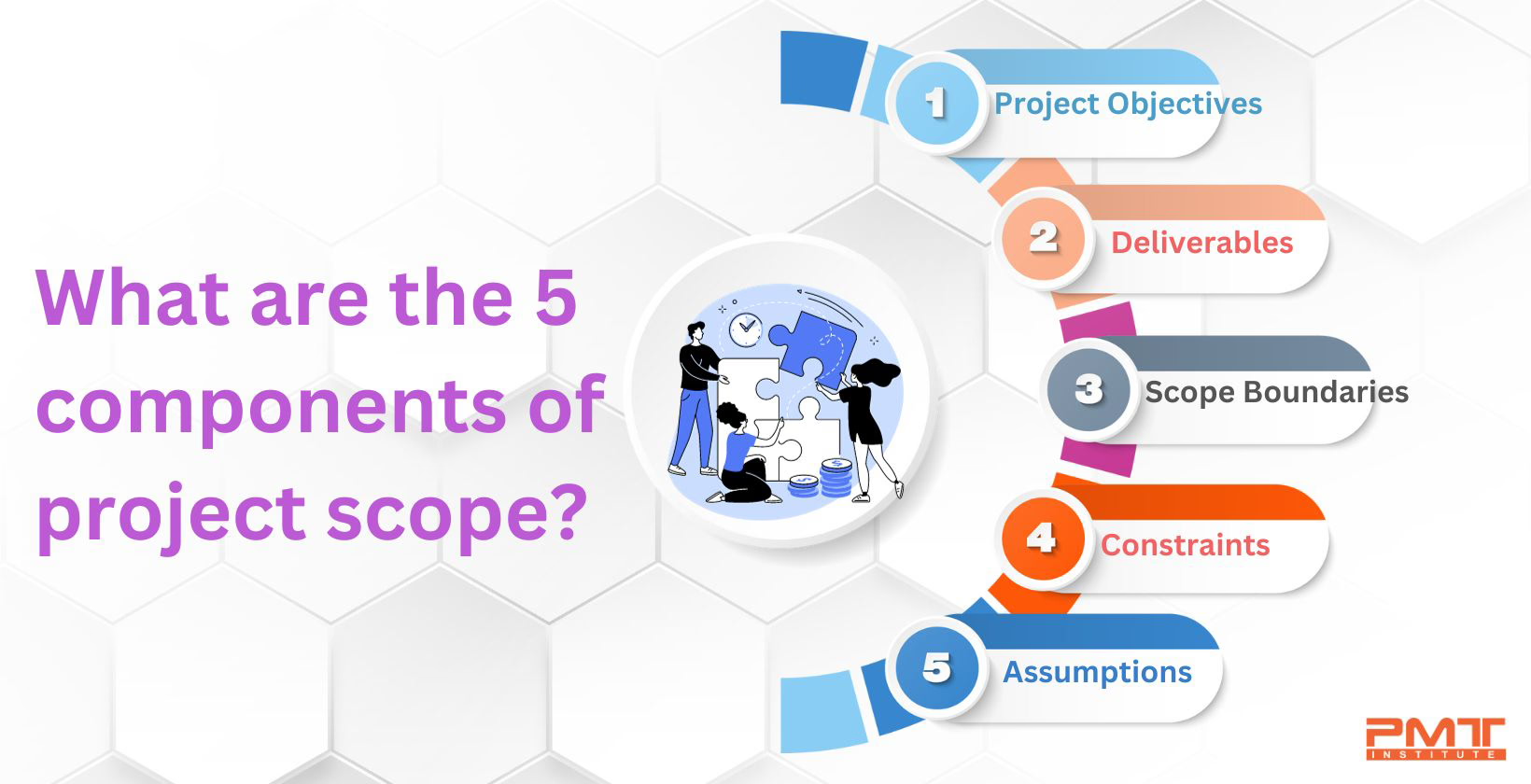What are the 5 components of project scope?
Published:
Updated:

In the realm of project management, project scope management is the foundational step that sets the stage for successful project execution. The project scope outlines the boundaries, objectives, and deliverables of the project, providing a clear roadmap for project teams and stakeholders. A well-defined scope is crucial for aligning project activities with organizational goals, managing expectations, and ensuring that project outcomes meet stakeholder's requirements.
In this detailed blog, we will explore the five fundamental components of project scope, which collectively form a robust framework for project managers to identify and manage project requirements effectively. Each component serves a unique purpose in shaping the project's direction, clarifying responsibilities, and facilitating good stakeholder management.
By understanding and implementing these components, project managers can optimize project planning, execution, and control, fostering project success in a dynamic business landscape.
Key Takeaways
- Project Objectives: Define the goals and deliverables of the project.
- Deliverables: Tangible and intangible outputs produced during the project.
- Scope Boundaries: Define what is included and excluded from the project scope.
- Constraints: Limitations and restrictions that affect project execution.
- Assumptions: Conditions assumed to be true for project planning.
- Importance: Clearly defining project scope ensures better project management and successful project outcomes.
1. Project Objectives
At the heart of every successful project lies a well-defined set of project objectives. The first and foremost component of project scope involves crafting clear, concise, and measurable project objectives that serve as the guiding light for all project activities. Project objectives are the ultimate destination towards which the project team navigates, providing a sense of purpose, direction, and focus throughout the project's lifecycle.
To create robust project objectives, project managers must collaborate closely with key stakeholders, including clients, sponsors, and end-users. This collaborative effort ensures that all relevant perspectives and requirements are considered, enabling the project team to align the project's objectives with the broader organizational strategy and vision.
Specificity is a critical aspect of crafting project objectives. Clear and well-defined objectives leave no room for ambiguity, ensuring that the project team understands precisely what is expected of them. Additionally, project objectives must be attainable and realistic, taking into account the available resources, time constraints, and technical feasibility.
Project objectives should be time-bound, indicating the desired timeframe for achieving each objective. This time element serves as a motivating factor, encouraging the project team to work diligently and efficiently towards completing the project within the stipulated deadlines.
Aligning project objectives with the organization's strategic goals is a strategic move that fosters seamless integration between projects and the broader organizational vision. A cohesive alignment ensures that the project's outputs contribute meaningfully to the organization's growth and success.
Throughout the project's lifecycle, project managers continuously monitor and evaluate the progress towards the defined objectives. Regular progress assessments help identify any deviations or challenges and enable timely corrective actions to get the project back on track.
Project objectives act as the foundation for effective project communication and stakeholder engagement. By clearly communicating the project objectives, project managers ensure that all stakeholders are on the same page, promoting a shared sense of purpose and commitment towards achieving the desired outcomes.
2. Deliverables
Deliverables are the tangible and intangible outputs that the project endeavors to produce, ultimately culminating in the fulfillment of the project objectives. These deliverables are the results of the collective efforts of the project team, representing the value and benefits that the project brings to stakeholders and end-users. A comprehensive understanding of deliverables is vital for project managers to effectively plan, execute, and monitor project activities, ensuring that each deliverable aligns with the project's objectives and contributes to the overall success of the endeavor.
Defining deliverables is a meticulous process that requires breaking down the project scope into specific, measurable, and well-defined components. These components may take various forms, ranging from physical products and tangible assets to intellectual property, such as software applications, research reports, or process improvements. Additionally, deliverables can also encompass intangible outcomes, such as improved customer satisfaction, enhanced brand reputation, or increased organizational efficiency.
During the project planning phase, project managers collaborate closely with stakeholders to identify and prioritize the deliverables that will best serve the project's purpose and stakeholders' needs. This collaborative effort helps align project activities with stakeholders' expectations, ensuring that the project team is working towards producing outcomes that provide tangible value and address the identified requirements.
Each deliverable within the project scope must have clearly defined acceptance criteria, outlining the specific conditions that must be met for the deliverable to be considered satisfactory and approved by stakeholders. These acceptance criteria serve as the basis for evaluating the quality and completeness of the deliverables, providing project teams with clear guidelines to meet stakeholders' expectations.
A well-defined set of deliverables facilitates effective project monitoring and progress tracking. As project activities unfold, project managers use deliverables as milestones to gauge the project's advancement and ensure that it remains on track. These milestones also provide an opportunity to engage stakeholders in milestone reviews, fostering transparency, and open communication throughout the project lifecycle.
Deliverables serve as essential reference points for project resource allocation and budget planning. By identifying the specific outputs required at each stage of the project, project managers can allocate resources efficiently, optimize task assignments, and avoid unnecessary delays.
A comprehensive deliverable list enhances risk management, allowing project teams to proactively address potential challenges and obstacles that may impact the timely delivery of project outputs. By anticipating risks associated with specific deliverables, project managers can devise contingency plans and mitigation strategies to safeguard project success.
Deliverables form the crux of project scope, embodying the tangible and intangible results that the project endeavors to achieve. Through careful identification, definition, and prioritization of deliverables, project managers ensure that project activities remain aligned with stakeholder expectations and project objectives. Well-defined deliverables serve as milestones for progress tracking, resource allocation, and risk management, providing project teams with a roadmap for successful project execution and delivering value to stakeholders.
By emphasizing the significance of deliverables, project managers enhance the clarity, efficiency, and efficacy of project planning and execution, positioning the project for success in a competitive and dynamic business landscape
3. Scope Boundaries
Project scope defines the boundaries and deliverables of a project. It outlines what is included and excluded from the project, detailing the specific objectives, tasks, milestones, and deliverables to be accomplished. Project scope provides a clear roadmap, ensuring all stakeholders understand what the project will achieve and the work required to complete it.
The third component of project scope involves defining the boundaries of the project. Scope boundaries delineate what is included and excluded from the project, providing clarity on the project's limits and preventing scope creep. Scope creep refers to the unplanned expansion of project scope, leading to delays, increased costs, and potential conflicts among stakeholders.
To establish scope boundaries, project managers must engage stakeholders in discussions about project requirements and expectations. By defining what is out of scope, project teams can manage stakeholder expectations and avoid unnecessary changes that could disrupt project progress.
4. Constraints
Project scope is often influenced by constraints that impact project planning and execution. Constraints are limitations and restrictions that project teams must work within to achieve project objectives successfully. Common constraints include budgetary limitations, time constraints, resource availability, legal and regulatory requirements, and technical limitations.
Identifying and documenting project constraints is essential for realistic project planning and risk management. Project managers must communicate constraints clearly to all stakeholders, as they directly impact the project's ability to deliver its intended outcomes.
5. Assumptions
The final component of project scope involves assumptions, which are factors that are considered to be true but have not been fully verified. Assumptions are inherent in every project and serve as the basis for decision-making and planning. However, it is essential to identify and document assumptions to avoid potential misunderstandings and risks.
Project managers must collaborate with stakeholders to identify assumptions and evaluate their potential impact on project outcomes. Assumptions can change over time, so regular reassessment and validation are crucial for maintaining project alignment and minimizing uncertainties.
Assumptions play a crucial role in shaping the trajectory of a project. Assumptions are the underlying beliefs or assertions made by project teams to facilitate decision-making and planning. These beliefs are considered true or valid without concrete evidence, and they form the basis upon which various project elements are established. Understanding and managing assumptions is paramount for project managers, as they influence project outcomes and can significantly impact project success.
Identifying assumptions requires a comprehensive exploration of the project's context, objectives, and constraints. Project managers engage with stakeholders, subject matter experts, and team members to surface potential assumptions and ensure they are thoroughly documented. By involving diverse perspectives in assumption identification, project managers reduce the risk of overlooking critical factors that could influence the project's progress.
Explicit and Implicit Assumption
It is essential to distinguish between explicit and implicit assumptions. Explicit assumptions are the ones that are explicitly stated and documented, while implicit assumptions are underlying beliefs that are not explicitly articulated but are implied in project discussions and decisions. Recognizing and validating both types of assumptions enhances the project team's understanding of the project's underlying dynamics and potential areas of uncertainty.
Once identified, project managers analyze and validate assumptions to assess their potential impact on project outcomes. Validation involves testing the accuracy and validity of assumptions through research, expert consultations, or historical data analysis. By validating assumptions, project teams can gain confidence in their viability and reduce uncertainties that may arise during project execution.
It is essential to recognize that not all assumptions will hold true throughout the project's lifecycle. As projects unfold, external factors, changing circumstances, and new information may challenge the validity of initial assumptions. Project managers must continuously monitor and revisit assumptions, updating them as needed to maintain project alignment and inform timely decision-making.
Managing assumptions effectively involves communicating them clearly to all project stakeholders. Transparent communication fosters a shared understanding of the project's underlying assumptions and encourages open dialogue among team members. By creating an environment where team members feel comfortable challenging assumptions, project managers promote a culture of continuous improvement and adaptability.
Moreover, assumptions significantly influence risk management. Assumptions can introduce risks when their validity is compromised or when they are based on uncertain or incomplete information. As such, effective risk management includes assessing assumptions' potential impacts and devising contingency plans to mitigate risks associated with invalidated assumptions.
Conclusion
The five components of project scope provide a robust framework for project managers to define, manage, and control project requirements effectively. By establishing clear project objectives, defining tangible deliverables, setting scope boundaries, recognizing constraints, and documenting assumptions, project managers create a solid foundation for successful project execution.
A well-defined project scope fosters effective communication, minimizes risks, and aligns project activities with organizational goals. Regularly revisiting and validating the project scope throughout the project life cycle ensures that the project remains on track and delivers its intended outcomes to the satisfaction of stakeholders.
In a dynamic business environment, where projects are subject to continuous change and evolving requirements, project managers must proactively manage scope to ensure project success. By leveraging the five components of project scope, project managers can navigate complexities, deliver value, and achieve project objectives with confidence and competence. Embracing a disciplined approach to scope management empowers project teams to adapt, innovate, and thrive in an ever-changing environment, cementing project management as a cornerstone of organizational success.


